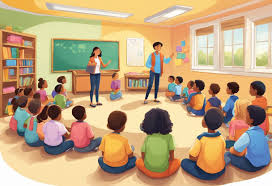The ancient tradition of storytelling remains fundamental to human learning, with the modern teacher serving as a contemporary storyteller guiding students through educational narratives. This pedagogical approach finds natural extension in kids animated shows, which deliver educational content through engaging storylines and memorable characters. Understanding the power of narrative across these contexts reveals important insights about effective learning.
Cognitive science research confirms that the human brain processes and retains information differently when presented in narrative format compared to isolated facts. Stories create connected neural networks that enhance both comprehension and recall, making narrative-based approaches particularly effective for young learners. This neural predisposition explains why both skilled teachers and quality animated programming often rely on storytelling frameworks.
The narrative structures employed by effective educators and animated educational content share remarkable similarities. Both typically feature relatable characters facing challenges, progressive complications requiring problem-solving, and resolution phases demonstrating learning or growth. This structural consistency creates familiar cognitive patterns that support information processing and retention.
Emotional engagement represents a crucial element in narrative-based learning. When stories—whether teacher-told or animation-presented—evoke emotional responses, they simultaneously activate multiple brain regions, creating stronger memory imprints. This emotional dimension explains why narrative-based information often shows superior retention compared to fact-based presentation.
Character identification plays a significant role in narrative education. Children readily identify with both characters described by teachers and those portrayed in animated programming. This identification creates psychological investment in learning outcomes and increases motivation to understand concepts integral to narrative resolution. The psychological mechanism remains consistent across delivery formats.
Conceptual scaffolding represents another advantage of narrative approaches. Complex ideas embedded within stories become accessible through narrative context, with abstract concepts made concrete through character experiences. This scaffolding effect works similarly whether the story comes from a classroom teacher or an animated program, creating accessible entry points to sophisticated concepts.
The transportive quality of narrative—the sense of entering another world or situation—creates immersive learning experiences that enhance focus and attention. Educational research confirms that this transportation effect increases information absorption and concept integration. Both skilled storytelling teachers and well-crafted animation achieve this transportive quality through different but complementary means.
Sequencing benefits emerge naturally in narrative education. Stories inherently present information in logical sequences, helping children understand cause-effect relationships, process steps, and chronological progression. This structured presentation aids comprehension and recall while developing sequential thinking skills crucial for numerous academic applications.
Memory enhancement represents one of narrative education’s most significant advantages. Information embedded in stories typically shows dramatically higher retention rates compared to disconnected facts. The narrative structure creates multiple retrieval cues—character associations, emotional connections, and plot linkages—that facilitate later recall for practical application.
Values education finds natural expression through narrative approaches. Rather than direct instruction about behavioral expectations or ethical principles, stories demonstrate values in action through character choices and consequences. This approach allows children to internalize values through vicarious experience rather than abstract instruction.
Implementation strategies for narrative education span both teacher-led and animation-based approaches. Effective techniques include connecting personal anecdotes to learning objectives, using storytelling voice modulation for emphasis, incorporating visual supports, building suspense through strategic pausing, and inviting prediction through questioning. These techniques enhance engagement regardless of delivery format.
Cross-cultural applications highlight narrative education’s versatility. Storytelling represents a universal teaching method across cultures, making narrative approaches particularly valuable in diverse classrooms. Both teacher stories and thoughtfully selected animated content can introduce cultural perspectives while simultaneously delivering curriculum content.
Digital storytelling—combining traditional narrative techniques with multimedia elements—represents an evolving educational frontier. Teachers increasingly create digital stories incorporating text, images, audio, and animation to create immersive learning experiences. This approach bridges between traditional storytelling and contemporary animation, combining elements of both traditions.
The neuroscience behind narrative learning continues revealing fascinating insights. Research using brain imaging technology shows distinctive neural activation patterns during story processing, with multiple brain regions engaging simultaneously. This neural integration helps explain why concepts presented narratively often transfer more readily to new contexts and applications.
As education continues evolving, the fundamental power of narrative remains constant across changing delivery methods. By recognizing storytelling as a cognitive bridge between traditional teaching and animated content, educators can intentionally leverage narrative structures across contexts, creating learning experiences that align with how children’s brains naturally process and retain information.

